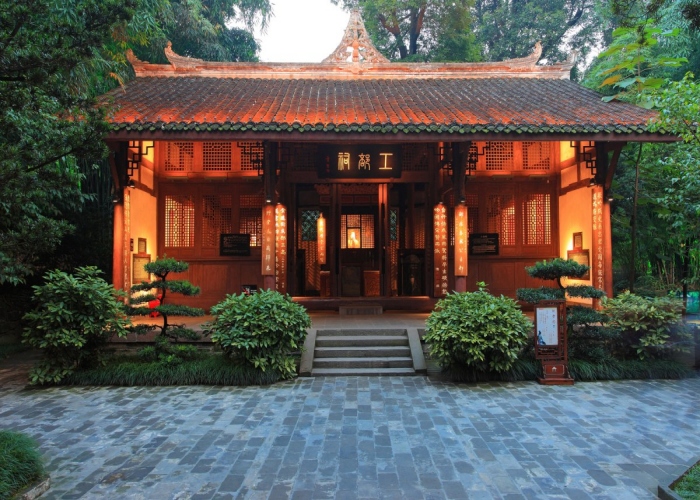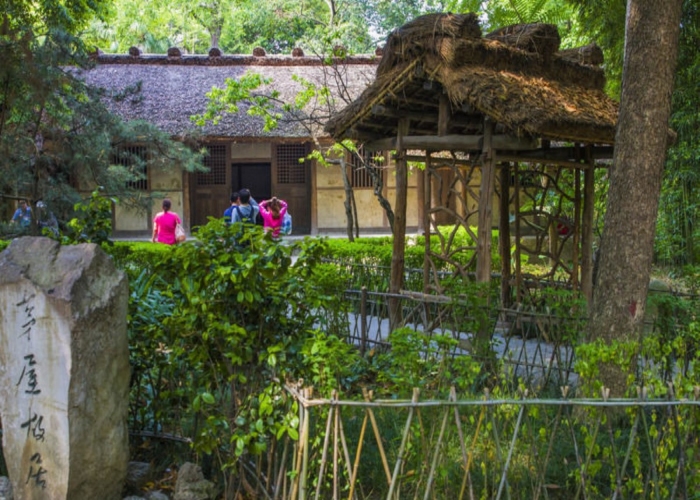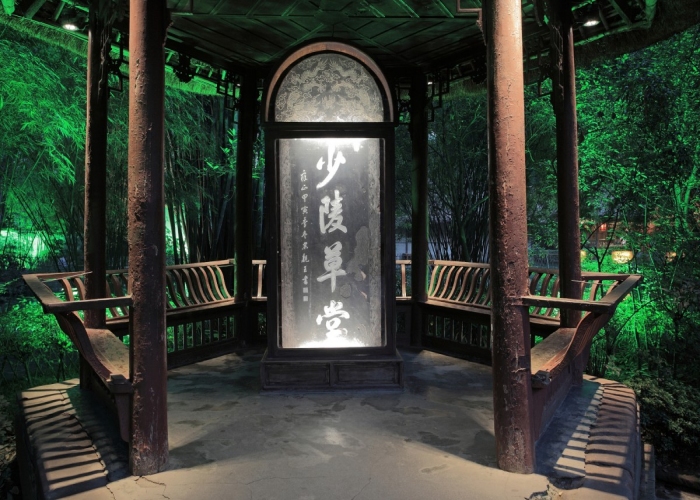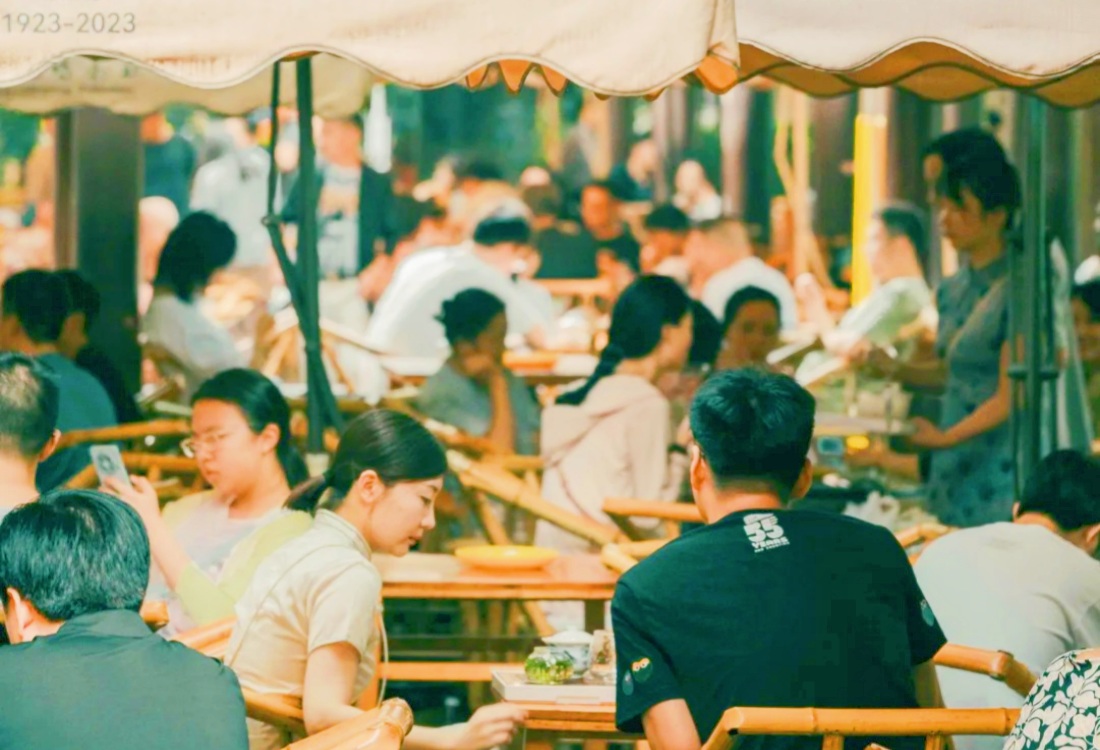Table of Contents
ToggleThis article will take you on a journey to one of Chengdu’s most cherished cultural landmarks: Du Fu Thatched Cottage. This peaceful retreat is far more than a historical site—it’s a living tribute to Du Fu, one of the greatest poets of the Tang Dynasty, and a place where history, literature, and natural beauty come together. Whether you’re a poetry lover, a cultural explorer, or simply seeking a peaceful escape in Chengdu, this guide will help you fully appreciate what makes Du Fu Thatched Cottage such a meaningful and memorable experience.
What is the History of Du Fu Thatched Cottage?
In 759 AD, famed Tang Dynasty poet Du Fu sought refuge in Chengdu during the chaos of the An-Shi Rebellion. With the support of friends and patrons, he built a modest thatched hut near Huanhua Brook. Despite humble living conditions, this serene setting inspired over 240 of his finest poems, rich in social insight, human emotion, and natural beauty. Although the original cottage did not survive, the site was honored from the Song Dynasty onward. Major reconstructions in the Ming (1500) and Qing (1811) dynasties shaped the complex seen today.Today, the Du Fu Thatched Cottage stands as a protected cultural site and 4A Scenic Spot, celebrating the poet’s enduring legacy.
What is the Top Attractions of Du Fu Thatched Cottage?
History in Verse Hall (Hall of Historic Poetry)
This hall is a treasure trove, displaying rare manuscripts, ancient calligraphy, translations of Du Fu’s poems in various languages, and artifacts. It offers deep insights into Du Fu’s life, his challenging experiences, and the powerful scenes depicted in his poetry. A life-sized bronze statue of Du Fu is also a prominent feature here.

Gong Bu Temple (Gong Bu Memorial Hall or Gongbu Shrine)
Named after Du Fu’s official post as a staff supervisor (Jianjiao Gongbu Yuanwailang) in the Ministry of Works. This hall is a central place for paying homage to the poet. It houses impressive statues of Du Fu, along with depictions of other prominent Chinese poets like Li Bai. An important artifact here is the earliest preserved stone carving of Du Fu’s bust, dating back to 1602 (Ming Dynasty).

The Thatched Cottage of Du Fu
A carefully reconstructed thatched hut stands as a symbol of Du Fu’s humble dwelling, allowing visitors to connect tangibly with his life of simplicityand immense creativity.

Shaoling Stele Pavilion (Tablet Pavilion)
Located east of the Gong Bu Temple, Shaoling Stele Pavilion is considered as a landmark attraction. “Shaoling” was another name Du Fu used for himself, referencing his ancestral home. A prominent stele inside, inscribed in 1734 by Prince Guo Yunzhi during the Qing Dynasty, features the calligraphy “Shaoling Caotang” (Shaoling Thatched Cottage).

The ‘ Remains of Tang Dynasty ’ Pavilion
The ‘Remains of Tang Dynasty’ Pavilion is located on the north side of the thatched cottage. It was excavated in 2001 and covers an area of 1,200 square meters. A large number of Tang Dynasty artifacts and fragments were unearthed from the Tang Dynasty Remains. It is one of the most important cultural remains of the Tang Dynasty in Chengdu. It shows the social life of the Chengdu area in the Tang Dynasty, makes up for the lack of Tang Dynasty objects in the exhibition of the poet’s former residence, confirms Du Fu’s description of his living environment and life scenes, and provides physical evidence for the historical evolution of Du Fu’s Thatched Cottage.

When is the Best Time to Visit Du Fu Thatched Cottage?
The best time to visit Du Fu Thatched Cottage in Chengdu, China, is during spring (March to May) or autumn (September to November) when the weather is mild and pleasant. Spring brings blooming flowers and lush greenery, enhancing the serene beauty of the cottage and its gardens, while autumn offers cool temperatures and golden foliage, creating a peaceful atmosphere. These seasons avoid the extreme heat and humidity of summer and the chilly dampness of winter, making exploration more comfortable. Additionally, visiting on weekdays or early in the morning helps avoid crowds, allowing for a more tranquil experience in this historic and poetic landmark.
What is the Essential Vistor Information for Du Fu Thatched Collage?
Category | Details |
Address | No. 37 Qinghua Road (or Qingyang Road), Qingyang District, Chengdu, Sichuan Province, China. (四川省成都市青羊区青华路37号) |
Opening Hours | Typically 08:00 – 18:00 daily (may vary slightly by season, e.g., 08:00-18:30 in summer, 08:00-18:00 in winter). Last entry usually 1 hour before closing. |
Best Time to Visit | Spring (March-May) for blooming flowers (especially plum blossoms) and pleasant weather. Autumn (September-November) for comfortable temperatures and beautiful foliage. |
How to Get There | By Metro: Take Chengdu Metro Line 4 to North Caotang Road Station (草堂北路站), Exit B. From there, it’s about a 10-15 minute walk south to the cottage. Or take Line 5 to Qingyang Palace Station (青羊宫站) and walk or take a short bus ride. By Bus: Numerous bus lines stop at or near “Dufu Caotang” (杜甫草堂站), including routes 35,58,82,151,165,170,1024,1031 |
Facilities | Restrooms, a small bookstore (Caotang Bookstore for souvenirs and books), and occasional refreshment stands. English signage is present, and guided tours may be available. |
Tips for Visitors | Wear comfortable shoes for walking. Consider bringing mosquito repellent during warmer months due to the lush greenery. |
Frequently Asked Questions (FAQs) of Du Fu Thatched Cottage?
What are the main things to see at Du Fu Thatched Cottage?
Key attractions include the reconstructed Thatched Cottage itself, the Gong Bu Temple (Memorial Hall), the History in Verse Hall with its exhibits on Du Fu’s life and works and the Shaoling Stele Pavilion, The “Remains of Tang Dynasty” archaeological site is also noteworthy.
Are there English guides or information available at Du Fu Thatched Cottage?
Yes, Du Fu Thatched Cottage generally has English signage for major exhibits and attractions. Audio guides in multiple languages are often available according to your needs. Additionally, you can sometimes pick English-speaking tour guides at the site for a more in-depth explanation.
How much time should I allocate for a visit to Du Fu Thatched Cottage?
It is recommended to allocate at least 2 to 3 hours for a visit to Du Fu Thatched Cottage. This allows enough time to explore the main halls, wander through the gardens, view the exhibits, and soak in the tranquil atmosphere.









